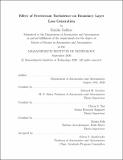Effect of freestream turbulence on boundary layer loss generation
Author(s)
Gakhar, Kanika.
Download1227279361-MIT.pdf (3.680Mb)
Other Contributors
Massachusetts Institute of Technology. Department of Aeronautics and Astronautics.
Advisor
Edward M. Greitzer, Choon S. Tan and Masha Folk
Terms of use
Metadata
Show full item recordAbstract
This thesis describes an analysis of the effect of freestream turbulence (FST) on turbulent boundary layer loss generation. A relation has been derived between a turbulence parameter, which characterizes the FST, and the increase in boundary layer dissipation coefficient. The relation gives guidelines for trade studies, for example between combustor turbulence properties and turbine performance in a typical gas turbine engine. Based on the FST length-scale, two regimes of FST influence have been defined, with consequent different functional dependencies between FST parameters and boundary layer dissipation coefficient. In one regime, characterized by self-similarity of mean velocity and turbulence production profiles, the dissipation coefficient is a function of local parameters, and can be determined using measurement data for effects of FST on skin-friction. In the second regime, the boundary layer deviates from equilibrium due to the lag between the rate of turbulence production and dissipation. For this latter case, a method has been developed to estimate the effect of FST on dissipation using a modified shear-lag model, based on the conservation of turbulent kinetic energy. This thesis shows that the increase in boundary layer loss due to local FST can be as high as 73%, and that non-equilibrium effects can result in an additional increase in boundary layer loss as high as 8%. Finally, the framework developed in this thesis has also been applied to an industry relevant situation, quantifying the effect of combustor turbulence on high pressure turbine (HPT) performance. Example trade studies show that increasing the size of dilution ports, increasing the length of the combustor, and rearranging or re-orienting the dilution jets in cross-flow in the combustor all can help decrease HPT profile loss generation, and potentially increase stage efficiency up to 0.5%.
Description
Thesis: S.M., Massachusetts Institute of Technology, Department of Aeronautics and Astronautics, September, 2020 Cataloged from student-submitted PDF of thesis. Includes bibliographical references (pages 197-201).
Date issued
2020Department
Massachusetts Institute of Technology. Department of Aeronautics and AstronauticsPublisher
Massachusetts Institute of Technology
Keywords
Aeronautics and Astronautics.